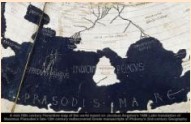
Source:Brisbane 4EB Sri Lankan Newsletter – Dæhæna – July 2021

Among Randika and Jerome’s many interests is a deep passion to understand Sri Lankan history and culture. This has been facilitated through exposure to multiculturalism through their travels and living experiences in multiple countries.
The term “Pearl of the Indian Ocean” reflects Sri Lanka’s significance to ancient explorers, traders and colonialist alike. This significance is observable through the island’s depiction on ancient maps. The size and details on this 15th century Florentine map (pictured) shows the prominent place it held in the minds of the cartographers of the era. Sri Lanka of the past could be considered akin to modern day Dubai, which became a sanctuary for people from across the globe. Unlike Dubai, many arrivals made the island their new home and contributed immensely to its ethnic, cultural, religious, culinary and linguistic diversity.
Sinhala and Tamil New Year (Avurudu) celebration is believed to be deep rooted in Sinhalese traditions. This celebration is a classic example of how centuries of settlement have influenced and become intimately intertwined within the tapestry of Sri Lankan life. Rabana from the Javan communities provide the iconic rhythm to “Dontha Babakkata” amongst many other raban pada. Lace tablecloth brought by the Portuguese cover the Avurudu table, whilst Kokis from the Dutch period adds colour to the spread alongside sponge cake, milk toffee and tea introduced by the British. Athirasa, dodol and sambals contributed by the Javan communities are served alongside pani walalu and murukku introduced by communities from India. Avurudu celebrations would be much less endearing in the absence of the many contributions from the aforementioned communities.
Many things quintessential to Sri Lankan culture including religions (such as Buddhism, Catholicism, Islam and Hinduism), sports (such as cricket and rugby), and vegetables (such as pumpkins, potatoes, tomatoes, chillies and cashews) amongst others have been introduced to the island from across the globe. The absence of bread, hoppers, string hoppers, dosa, vada and pittu from our breakfast tables, or biriyani, lamprais, potato/pumpkin/cashew/bean curries from our lunch tables would lead to a vapid culinary landscape on the island.
Modern day Sri Lanka is a result of true intergenerational multiculturalism. Sri Lankans have not just embraced the cultures and cuisines but each other. Millennia of interethnic marriages/unions have resulted in a unique situation where no two siblings look alike, or where no two families practice the same set of customs. Our island is a place that is more multicultural than we are made to believe and we should embrace this diversity in order to appreciate the truly unique place Sri Lanka occupies in the world.






